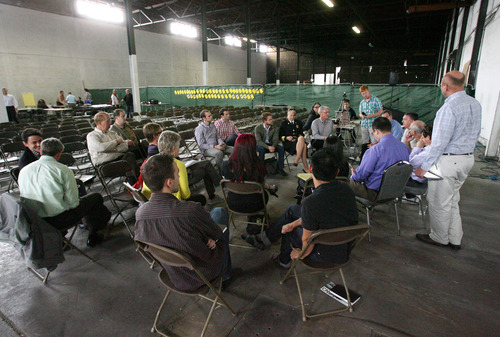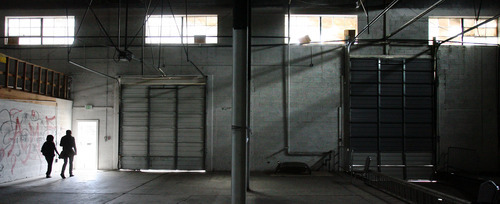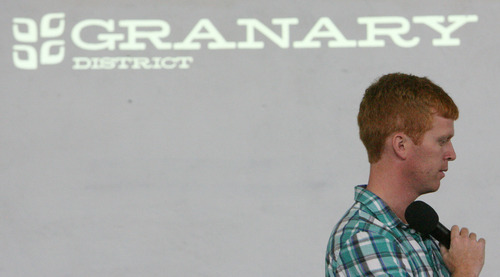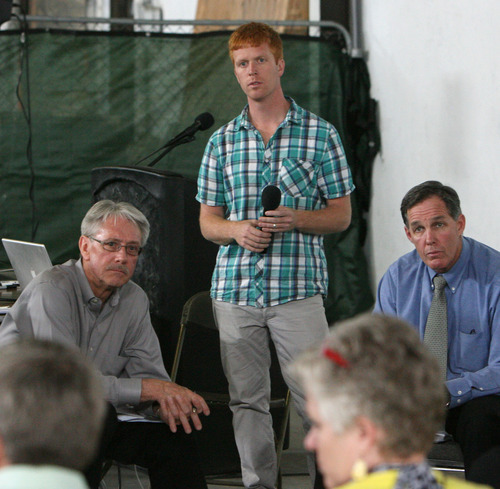This is an archived article that was published on sltrib.com in 2012, and information in the article may be outdated. It is provided only for personal research purposes and may not be reprinted.
A jargony social media notion — crowdsourcing — may be the wellspring for how Salt Lake City revives the blighted Granary District on the west edge of downtown.
In 2008, James Alfandre has used a blog, Facebook, Twitter and a web site to get people talking about options for breathing new life into the no-man's land of old warehouses, commercial buildings and vacant lots roughly bounded by 600 and 900 South, 300 West and Interstate 15.
Last year, Alfandre's nonprofit Kentlands Initiative organized a block party with entertainment, two outdoor cafes and temporary trees to generate more buzz about the district's potential. More than 1,000 people, including Mayor Ralph Becker and members of the city council, attended.
Over the ensuing months, the 29-year-old transplant from Washington, D.C., put together a movie night for the neighborhood, a barbecue and several coffee klatches. Alfandre also ran a campaign among residents and businesses to identify the neighborhood's "brand."
"He's a great guy," said Lou Barrett, a co-owner of the century-old Pickle Factory at 741 S. 400 West. Located at the very center of the district, Barrett's building houses several art studios on two floors. His wife, Carolyn, plans to open a coffee shop and book store later this year.
"I find what [Alfandre]'s been doing at the Granary District pretty extraordinary, the whole plan and the vision of it," Barrett said. "I really like some of his ideas of creating urban living space for people, where you can live, work and play in the same neighborhood."
Alfandre's recent crowdsourcing effort was to stage a "charrette" — a week-long potpourri of workshops, tours and brainstorming sessions between April 25 and May 1 that addressed issues such as the area's cultural assets, urban growth patterns, economic development and transportation possibilities. Alfandre hoped 100 people would come; 400 showed up.
"I'm a nonprofit whose mission it is to help neighborhoods become more than what they are," said Alfandre, whose vision of the Granary District runs to what he says are the aspirations of the Millennial Generation, also known as Generation Y, the Net Generation and the Me Generation. Rather than sprawling car-based development, Millennials want to live in compact, pedestrian-friendly neighborhoods populated by young and old, rich and poor, he said.
"We really don't want to spend money on cars or driving. We'd rather spend our money on social experiences. Luxury items aren't important to us. It's a lifestyle," Alfandre said, citing a finding by consulting firm RCLCO that 77 percent of Gen-Yers want to live some form of the urban life.
Young as he is, Alfandre is no johnny-come-lately to urban development. He grew up in a family that built things. His maternal grandfather, Sid Foulger, built the former Crossroads Plaza in downtown Salt Lake City. Alfandre's dad, Joe Alfandre, built Kentlands, a planned neighborhood in Gaithersburg, Md., outside Washington, D.C., that aimed to answer how to create a modern neighborhood with a traditional mix of houses, shops, businesses, churches, offices, schools and recreation in a walkable environment for residents of all ages.
Kentlands began in 1988. Since then, developers have tried to reproduce the concept in other parts of the U.S. James Alfandre said Kennecott Land toured Kentlands before it broke ground on Daybreak, the new "urbanist" community in South Jordan, where, according to Daybreak, one out of every five new homes in the Salt Lake Valley is sold today. Alfandre sees the Granary District as a next-generation Kentlands, which he says offers a great lifestyle to residents but, after a quarter-century, still is missing several amenities.
"You still have to drive outside the community. It's still kind of an island," he said.
Instead of a community built from scratch, the Granary District ought to be a mix of existing structures and new buildings constructed on the area's empty lots, Alfandre said. The details that emerged from the charrette — such things as bike lanes, housing types, construction methods and small-business preferences — will be presented to City Council in the next month or two. The hope is that the neighborhood's "vision plan" will help guide the city as it sets about rezoning the district this summer, he said.
"They will be able to look at it and see whether it's a kind of guiding vision for the neighborhood or it could be refined into a master plan," Alfandre said. "The City Council are kind of waiting to look at it themselves to see how it could be best used."
Twitter: @sltribpaul More about the Granary neighborhood
Facebook • http://www.facebook.com/granarydistrictslc
Pinterest • This bulletin board offers the recommended urban aesthetic of the district : http://www.pinterest.com/hspung/granary-district-project
Website • granarydistrict.org









